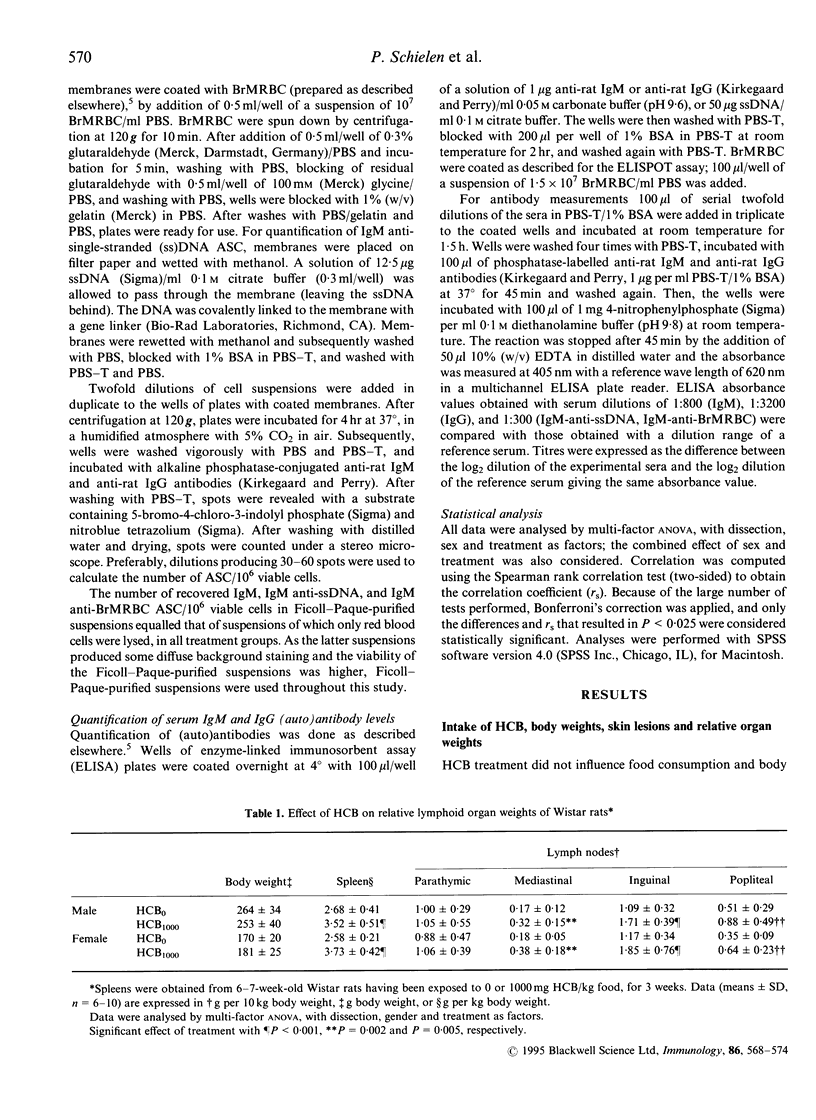Abstract
In the present study, the role of B-1 cells in hexachlorobenzene (HCB)-induced autoimmune aberrations in the Wistar rat was investigated. To that end, male and female rats were exposed to a semi-synthetic diet containing 0 or 1000 mg HCB/kg food for 3 weeks. After dissection, serum was prepared form coagulated blood to determine (auto)antibody levels, and spleens and lymph nodes were isolated and weighed. Cell suspensions were prepared, counted and analysed for B- and T-cell subsets by flow cytometry. Quantification of antibody-secreting cells (ASC) in spleen cell suspensions was done with an ELISPOT assay. Previous findings that HCB treatment induced an increase of relative lymph node and spleen weights and serum (auto)antibody levels were confirmed, while it appeared that numbers of some lymph nodal, and of the splenic large cell populations, were elevated as well. HCB treatment did not change subsets of lymph nodal T and B cells, but elevated the absolute numbers of large splenic CD4+ T cells by about 70%, IgMdull/IgDbright B cells by about 60%, and IgMbright/IgDdull B cells by about 200% cells of control numbers, and the absolute numbers of splenic IgM and IgG (auto) ASC by 300-400% of the control numbers. As splenic IgMbright/IgDdull numbers and ASC numbers correlated with statistical significance, the results indicate that HCB treatment selectively activates rat splenic B-1 cells, which may underlie the elevation of serum autoantibody levels.
Full text
PDF






Selected References
These references are in PubMed. This may not be the complete list of references from this article.
- Adams L. E., Hess E. V. Drug-related lupus. Incidence, mechanisms and clinical implications. Drug Saf. 1991 Nov-Dec;6(6):431–449. doi: 10.2165/00002018-199106060-00004. [DOI] [PubMed] [Google Scholar]
- Ansar Ahmed S., Dauphinée M. J., Montoya A. I., Talal N. Estrogen induces normal murine CD5+ B cells to produce autoantibodies. J Immunol. 1989 Apr 15;142(8):2647–2653. [PubMed] [Google Scholar]
- Ansar Ahmed S., Penhale W. J., Talal N. Sex hormones, immune responses, and autoimmune diseases. Mechanisms of sex hormone action. Am J Pathol. 1985 Dec;121(3):531–551. [PMC free article] [PubMed] [Google Scholar]
- Avrameas S. Natural autoantibodies: from 'horror autotoxicus' to 'gnothi seauton'. Immunol Today. 1991 May;12(5):154–159. doi: 10.1016/S0167-5699(05)80045-3. [DOI] [PubMed] [Google Scholar]
- Brideau R. J., Carter P. B., McMaster W. R., Mason D. W., Williams A. F. Two subsets of rat T lymphocytes defined with monoclonal antibodies. Eur J Immunol. 1980 Aug;10(8):609–615. doi: 10.1002/eji.1830100807. [DOI] [PubMed] [Google Scholar]
- Cripps D. J., Peters H. A., Gocmen A., Dogramici I. Porphyria turcica due to hexachlorobenzene: a 20 to 30 year follow-up study on 204 patients. Br J Dermatol. 1984 Oct;111(4):413–422. doi: 10.1111/j.1365-2133.1984.tb06603.x. [DOI] [PubMed] [Google Scholar]
- Gray D., MacLennan I. C., Bazin H., Khan M. Migrant mu+ delta+ and static mu+ delta- B lymphocyte subsets. Eur J Immunol. 1982 Jul;12(7):564–569. doi: 10.1002/eji.1830120707. [DOI] [PubMed] [Google Scholar]
- Herzenberg L. A., Stall A. M., Lalor P. A., Sidman C., Moore W. A., Parks D. R., Herzenberg L. A. The Ly-1 B cell lineage. Immunol Rev. 1986 Oct;93:81–102. doi: 10.1111/j.1600-065x.1986.tb01503.x. [DOI] [PubMed] [Google Scholar]
- Kantor A. B. The development and repertoire of B-1 cells (CD5 B cells). Immunol Today. 1991 Nov;12(11):389–391. doi: 10.1016/0167-5699(91)90136-H. [DOI] [PubMed] [Google Scholar]
- Kroese F. G., Butcher E. C., Lalor P. A., Stall A. M., Herzenberg L. A. The rat B cell system: the anatomical localization of flow cytometry-defined B cell subpopulations. Eur J Immunol. 1990 Jul;20(7):1527–1534. doi: 10.1002/eji.1830200718. [DOI] [PubMed] [Google Scholar]
- Mongey A. B., Hess E. V. Drug and environmental effects on the induction of autoimmunity. J Lab Clin Med. 1993 Dec;122(6):652–657. [PubMed] [Google Scholar]
- Peters H. A., Gocmen A., Cripps D. J., Bryan G. T., Dogramaci I. Epidemiology of hexachlorobenzene-induced porphyria in Turkey: clinical and laboratory follow-up after 25 years. Arch Neurol. 1982 Dec;39(12):744–749. doi: 10.1001/archneur.1982.00510240006002. [DOI] [PubMed] [Google Scholar]
- Peters H., Cripps D., Göcmen A., Bryan G., Ertürk E., Morris C. Turkish epidemic hexachlorobenzene porphyria. A 30-year study. Ann N Y Acad Sci. 1987;514:183–190. doi: 10.1111/j.1749-6632.1987.tb48773.x. [DOI] [PubMed] [Google Scholar]
- Schielen P., Schoo W., Tekstra J., Oostermeijer H. H., Seinen W., Bloksma N. Autoimmune effects of hexachlorobenzene in the rat. Toxicol Appl Pharmacol. 1993 Oct;122(2):233–243. doi: 10.1006/taap.1993.1192. [DOI] [PubMed] [Google Scholar]
- Talal N., Dauphinee M., Ahmed S. A. CD5 B cells in autoimmunity. Ann N Y Acad Sci. 1992 May 4;651:551–556. doi: 10.1111/j.1749-6632.1992.tb24661.x. [DOI] [PubMed] [Google Scholar]
- Vos J. G., van Logten M. J., Kreeftenberg J. G., Kruizinga W. Hexachlorobenzene-induced stimulation of the humoral immune response in rats. Ann N Y Acad Sci. 1979 May 31;320:535–550. [PubMed] [Google Scholar]


